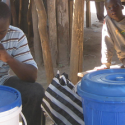The art of Mabisi production: a traditional fermented milk

This manuscript “The art of Mabisi production: a traditional fermented milk” is linked to the Global Challenges Programme project on traditional fermented foods in Zambia and describes the different processing practices of traditional Mabisi production in Zambia.
Abstract
Food fermentation is an important process for the production of a variety of foods rich in nutrients, flavour and with extended shelf-life. Fermented dairy products can also be rich in beneficial microbes and one such product with potential is mabisi. Mabisi is a traditional fermented milk product from Zambia made through spontaneous fermentation of raw milk at ambient temperature using a calabash (gourd), clay pot, plastic or metal container. The fermentation takes about 48 hours after which the product is stirred and ready for consumption. The aim of this study was to determine the types of production methods of mabisi and identify the critical production process parameters. A survey was conducted using interviews and observations to determine the existing production practices/technologies and to capture indigenous knowledge on mabisi production in nine provinces of Zambia. We found seven different production methods which we coined; tonga, thick-tonga, illa, barotse, backslopping, cooked and creamy types. Interestingly, the tonga-type mabisi was produced throughout the country by different ethnic groups. The main process parameters were found to be fermentation time and temperature, type of containers, presence/absence of backslopping, agitation, heating and cooling, removal of whey and addition of raw milk. And further found that mabisi is a versatile product consumed with a wide variety of foods. This basic information is crucial for production process optimisation and microbial communities dynamics studies.






